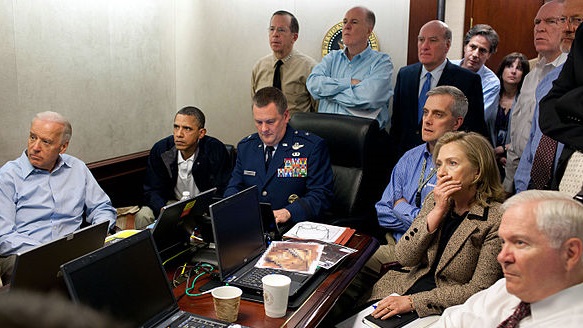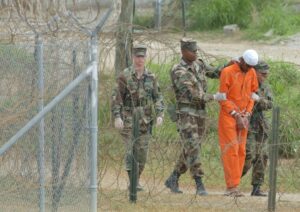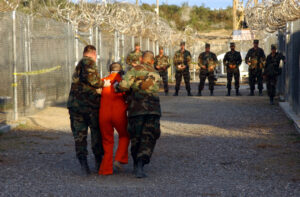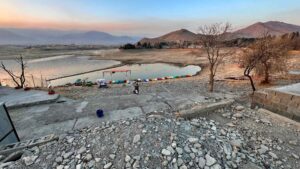American History for Truthdiggers: The Obama Disappointment
The 44th president failed in foreign policy and saw a rise in racial tensions: The "Hope and Change" candidate could not deliver. President Barack Obama in the White House situation room on May 1, 2011, watching live updates from the military operation that killed terrorist leader Osama bin Laden. Among those with him are Vice President Joe Biden and Secretary of State Hillary Clinton. (White House photographer Pete Souza)
President Barack Obama in the White House situation room on May 1, 2011, watching live updates from the military operation that killed terrorist leader Osama bin Laden. Among those with him are Vice President Joe Biden and Secretary of State Hillary Clinton. (White House photographer Pete Souza)
Editor’s note: The past is prologue. The stories we tell about ourselves and our forebears inform the sort of country we think we are and help determine public policy. As our current president promises to “make America great again,” this moment is an appropriate time to reconsider our past, look back at various eras of United States history and re-evaluate America’s origins. When, exactly, were we “great”?
Below is the 37th installment of the “American History for Truthdiggers” series, a pull-no-punches appraisal of our shared, if flawed, past. The author of the series, Danny Sjursen, who retired recently as a major in the U.S. Army, served military tours in Iraq and Afghanistan and taught the nation’s checkered, often inspiring past when he was an assistant professor of history at West Point. His war experiences, his scholarship, his skill as a writer and his patriotism illuminate these Truthdig posts.
Part 37 of “American History for Truthdiggers.”
See: Part 1; Part 2; Part 3; Part 4; Part 5; Part 6; Part 7; Part 8; Part 9; Part 10; Part 11; Part 12; Part 13; Part 14; Part 15; Part 16; Part 17; Part 18; Part 19; Part 20; Part 21; Part 22; Part 23; Part 24; Part 25; Part 26; Part 27; Part 28; Part 29; Part 30; Part 31; Part 32; Part 33; Part 34; Part 35; Part 36.
* * *
Most serious historians, especially academics, believe that accounts of recent events—particularly within 10 years of the present—are more journalistic than historical. It is for good reason that journalism has been called the “first draft of history.” As the “American History for Truthdiggers” series nears an end, it looks at the administration of Barack Obama, who left the presidency less than 32 months ago. Because so little time has passed, the essay below is more a brief, analytical essay than a comprehensive reading based on established, long-scrutinized historical sources and discovery of new information. It should be viewed as this author’s first draft of rather recent history. —Danny Sjursen
* * *
Barack Hussein Obama. That a man with a black Kenyan father and a name derived from African and Islamic etymology was elected president of the United States seemed profound indeed. America’s legacy of chattel slavery and racial apartheid was such that only a decade and a half before the 2008 election Tupac Shakur would rap that Americans “ain’t ready to see a black president.” Nonetheless, Obama won—with authority—over his Republican opponent, Sen. John McCain of Arizona. By carrying traditionally Republican states such as Virginia, North Carolina and Indiana, Obama appeared to have forged a new Democratic coalition. Perhaps more important was the claim of some of his admirers that he inaugurated a new “post-racial” America. That would turn out to be only wishful thinking.
Without the utter, historical failure and (by then) unpopularity of the George W. Bush administration, due largely to the 2007-2008 financial collapse and the intractable, unwinnable Iraq War, a man with Obama’s name and skin color would never have been elected. Indeed, it might have taken many more decades to elect a black president. Such is the contingency of history. Seen in this light, Obama was as much anomaly as transformational. Never as progressive as his rhetoric, always the astute—and ultimately mainstream—politician first, and often fearful of appearing “weak” or providing ammunition for his intransigent Republican opposition, President Obama proved disappointing for liberals and tragic for the Greater Middle East.
Tribal America: Party Over Country and More of the Same
Obama entered the spotlight and rose to national celebrity almost overnight. A last-minute choice to deliver the keynote address at the Democratic National Convention in 2004, the then-little-known Illinois state senator (running for the U.S. Senate at the time) delivered a thunderous and articulate address. This new, young face of color inspired the audience with his call for unity in a time of partisan division. Those who divide the nation into red states and blue states are incorrect, he said, declaring, “We are one people, all of us pledging allegiance to the stars and stripes, all of us defending the United States of America.” The speech was indeed excellent. Yet, as Obama’s later tenure as president would illustrate, the young state senator himself was wrong: There were, and are, two Americas. The people, and especially their elected representatives, were and are tribal and divided. The result for the Obama presidency was often stalemate, infighting and rightward moderation of even Obama’s most modest “liberal” legislation. In other words, the 44th president’s domestic policy was fated to be more of what had come before.
Obama entered the presidency at the nadir of what was dubbed the “Great Recession,” America’s worst economic collapse since the Great Depression. Decades of right-wing, hypercapitalist, free-market orthodoxy—combined with fiscal deregulation, much of it stemming from President Bill Clinton’s policies—had set the stage for that collapse. Nonetheless, it was Obama who was expected to pick up the pieces and who would have his legacy judged by his response to the fiscal free fall. As a relative newcomer and an ostensible outsider among the party’s “New Democrat” leaders, Obama had a profound opportunity to forever transform the American economy and stanch the growing economic inequality plaguing the nation. That this was not to be became clear when the new president appointed an economic team spearheaded by Wall Street-friendly Clinton administration veterans such as Timothy Geithner and Lawrence Summers. Rather than nationalize banks, “bust” monopolies and pass a true New Deal-style public works and massive stimulus program, Obama—partly due to partisan opposition, it must be admitted—settled on a modest stimulus, weak financial regulations, counterintuitive tax cuts and a taxpayer-financed bailout of the criminals atop the nation’s largest corporations. None of the company executives were punished, most received “golden parachute” bonuses and America’s flawed, radically rightist economy remained in place.
Next, though he had been warned by his staff that it was politically unpalatable, Obama decided to move for health care reform, a goal long sought by liberals. Democratic presidents from Harry Truman to Lyndon Johnson to Bill Clinton had tried to achieve something approaching universal health care coverage for the citizenry but had failed in the face of fierce Republican opposition and the well-funded lobbying efforts of the lucrative private insurance industry. Obama meant to succeed where his predecessors had failed. Nonetheless, precisely because of his obsession with getting something passed in Congress, the president failed to seriously alter America’s broken health care system. Realizing that Republican opposition, and Americans’ fear of the boogeyman of “socialized medicine,” remained strong, Obama never seriously considered the single-payer, universal coverage system prevalent and successful in most of the Western World. Though European single-payer, government health care systems cost far less than the American employer-based system, and though health outcomes in the privatized U.S. system lagged behind those of its industrialized peers, Obama decided that only a hybrid compromise had any chance of passing Congress. Perhaps he was right, but the new president did seem to fold rather quickly, and utterly failed to sell the logic of single-payer, universal coverage directly to the American people as both cost-effective and inherently moral.
Republican opposition to Obama’s eventual plan, the Affordable Care Act (ACA)—rapidly, if pejoratively, dubbed “Obamacare”—was vehement and cynical. The ACA, after all, kept in place the employer-based system (almost unique to the United States) and was even based on Republican models and plans, such as the Massachusetts system under Mitt Romney (who in 2012 would run against Obama) and a 1989 recommendation of the conservative Heritage Foundation. In a staggering bit of political chicanery, Republicans—including former Gov. Romney—who had once championed such plans unapologetically flip-flopped into fierce opposition as soon as the ACA took on an Obama and Democratic flavor. Luckily for Obama and the Dems, the party had won slight House and Senate majorities in 2006 and 2008 as the electorate reacted to the failures of Bush. Thus, the chief executive and his party had enough votes to get the ACA compromise passed although nearly no congressional Republicans supported the legislation. In order to get the ACA through, however, Obama had to eliminate its most progressive aspects, including the “public option” to purchase insurance from the government and public funding for birth control and abortions. So it was that a watered-down health care bill—only modestly improving on what already existed—barely squeezed by in Congress. Ultimately, millions of Americans were left still uninsured.
If Obamacare was a tactical “success,” it seemed a strategic failure. The Republicans rallied in opposition to so-called socialized medicine and ran against the bill in 2010, 2012 and 2014, scoring major electoral victories in Congress. No doubt, the “old guard” Republican leadership in the House and Senate had been intransigent from the start. After all, the GOP leaders had put politics before country from the first, with Senate Minority Leader Mitch McConnell literally stating that his party’s top priority in 2009 was to ensure Obama would be “a one-term president.” Still, this was nothing compared with the racialized, populist furor of the grass-roots “tea party” movement that arose in opposition to the ACA and Obama’s modest economic stimulus plan (meant to save capitalism as it existed, mind you). Republicans swept to control of the House in 2010, took the Senate back soon afterward and ensured that Obama would achieve no further major legislative achievements. Stagnation, intransigence and filibuster would epitomize Obama’s second term.
Left without any real legislative options, Obama was forced—under questionable constitutional circumstances—to address the nation’s worst problems through a series of modest executive orders. As such, he provided minor protections to “illegal” immigrants who had spent most of their lives in the U.S., while at the same time deporting a record number of undocumented migrants, a practice that earned him the nickname “deporter in chief” among progressives. Worse still, even amid escalating gun violence and the uniquely American epidemic of mass shootings (notably the execution of first- and second-graders and others at Sandy Hook Elementary School in Connecticut), Obama could not pass a single piece of basic, common-sense gun control. As Republicans closed ranks, rejected any limitations on the widely misunderstood Second Amendment and cashed in on massive donations from the National Rifle Association lobby, the president could again only issue a few limited executive orders. Nothing, however, stopped the epidemic of mass shootings in a country with more guns per capita than any other place in the world. That lawless Yemen was a distant second ought to have been instructive.
The U.S. also suffered a racial implosion under the first black president, and the racial harmony that had been hoped for proved to be out of reach. Highly instrumental in the public unrest was the vastly increased use of cell phone cameras and YouTube and other branches of social media, allowing widespread and almost instantaneous dissemination of images that caused outrage. Depictions of brutality by militarized police, specifically police killings of a string of unarmed young black men, helped launch a new grass-roots civil rights movement named Black Lives Matter. BLM, often critical of the centrism of Obama, was a true grass-roots movement, rising as names such as Trayvon Martin, Michael Brown, Eric Garner, Tamir Rice and Freddie Gray resonated. In response to the almost totally peaceful BLM-influenced nationwide protests, a newly empowered white supremacist backlash appeared. Blandly titling itself the “alt-right,” this extremist movement built upon a sense of white victimization. Epitomized by the massacre of Bible study worshippers in a historically black church in Charleston, S.C., at the hands of a young white radical named Dylan Roof—who had consumed news from alt-right sources—newly powerful and overtly extreme groups of white supremacists seemed here to stay.
Far from inaugurating the post-racial America of popular fantasy, Obama’s presidency, and the backlash against it, ushered in a new age of reinvigorated racial combat sure to extend well past his second term. And, while the dog-whistle politics of the Republican Party no doubt fanned the flames of racist fire, the American people—especially hateful, insecure whites—bore equal responsibility for what followed.
Obama the Superficial: The Inertia and Expansion of the ‘Terror’ Wars
It is highly unlikely that Obama would have defeated the Democratic favorite, Hillary Clinton, in the primaries of 2008 or the veteran senator and war hero John McCain in the general election had it not been for the widespread opposition to Bush’s foolish, dishonest and illegal invasion of Iraq. By 2008, that country was fractured, unstable, violent, in the midst of stalemated civil war and a haven for Islamist jihadism. Whereas Clinton had taken the then (she thought) politically expedient decision to vote in favor of the Iraq invasion, Obama had, at the time, seemed to oppose the war.
Then again, it was easy for him to do so. As a lowly and obscure state senator in a safe Chicago district, he knew he would pay no political price for rowing against the prevailing nationalist tide. Thus he made a critical speech before the invasion that he later used to burnish his anti-war credentials and separate himself (successfully, it turned out) from Clinton. Still, Obama’s speech wasn’t, instructively, against all wars, but rather—as he termed it—against “dumb wars.” Furthermore, had Obama been a national figure, it’s likely he would have voted right along with the former first lady and her mainstream Democratic colleagues. That Obama, as president, proved to be a standard interventionist and even expanded the post-9/11 “forever wars” further bolstered this supposition.
It took him nearly three years, but Obama as president did pull nearly all American troops out of Iraq. Hiding behind the politically and militarily popular myth that George W. Bush and Gen. David Petraeus’ 2007-2010 “surge”—which Sen. Obama had rightly, if ironically, opposed—had been successful, the new president was able to do so despite (mostly) Republican opposition. In truth, the Iraqi civil war had taken only a temporary pause, and Sunni jihadism had hardly disappeared. On the contrary, Petraeus had simply shortsightedly bought their temporary allegiance. Once the Americans were gone and the cash stopped flowing, the al-Qaida franchise in Iraq rose again like the mythical phoenix and went back to war in both Iraq and the nearby, by then war-torn Syria under the banner of the newly christened Islamic State (ISIS). By 2016, as Obama prepared for an undoubtedly lucrative retirement, U.S. troops were back in Iraq battling the Frankenstein’s monster of Islamist jihadism that the American invasion had helped create.
In what he would absurdly referred to as the “good war” in Afghanistan, Obama sold out the tiny antiwar movement and tripled U.S. troop levels in his own Bush-like “surge.” American and Afghan casualties soared, but the Taliban was never defeated and the corrupt, U.S.-backed Kabul-based regime still lacked legitimacy. Though he had promised his surge would be temporary and that all troops would withdraw by the end of 2014, more than 10,000 remained in country in 2016. By that time, some 2,300 U.S. military deaths had not changed the prevailing facts on the ground in this most unwinnable of wars: The Taliban controlled more of the country than at any time since 2001, the Afghan central government was financially broke and politically ineffective, and casualties in the Afghan security forces were massive and unsustainable. The war was essentially lost, though Obama would never admit it. Indeed, by the end of his second term he preferred not to mention the “good war” at all.
In 2011, in opposition to a series of venal, authoritarian—usually U.S.-backed—regimes, a series of “Arab Spring” protests spread across the Mideast from Tunisia to Libya to Egypt to Yemen to Bahrain to Syria. The movement seemed to spring from the grass roots but was complicated and multifaceted from the start. There were, indeed, early signs that though the dictatorships were abhorrent, Islamist jihadis were quickly infusing, and soon dominating, the armed rebel groups and protesters. Obama, for his part, was unsure how to respond. His humanitarian-interventionist conscience leaned toward moral and physical support for the varied oppositions, but his caution and practicality led him away from decisive action in either direction. In the end, Obama—cheered on by his militarist advisers such as Secretary of State Hillary Clinton—chose the worst of all roads: indecisiveness, inconsistency and (sometimes) ill-considered intervention.
The inconsistency was obvious from the start and increased the popular notion on the “Arab street” that U.S. policy was infused with hypocrisy. While Obama eventually called for the rulers of Egypt, Tunisia, Yemen, Libya and Syria to step down, he turned a blind eye to Saudi Arabia’s military suppression of Shiite majoritarianism in nearby Bahrain. Furthermore, in 2015, when a vaguely Shiite militia movement, the Houthis, overthrew the Saudi-backed transitional government in Yemen, Obama quietly provided vital diplomatic and military support for a U.S.-backed Saudi terror war on Yemen. Saudi planes, fueled by U.S. Air Force aircraft, unleashed a brutal bombing campaign that killed tens of thousands. Furthermore, the U.S. uttered not a peep as a Saudi starvation blockade led to the deaths of nearly 100,000 civilians, created millions of refugees and unleashed the world’s worst cholera epidemic on Yemeni civilians. Washington, it seemed, supported democracy so long as it did not upset its oil-rich Persian Gulf State “partners.” Clearly, there were limits to the “humanitarian” piece of Obama’s humanitarian-interventionist proclivities.
Obama’s worst move during the Arab Spring—a move that, to his credit, he later called a “shit show” and the “worst mistake” of his presidency—came in Libya. There, a brutal dictator, Moammar Gadhafi, had ruled for decades, suppressing free speech but also choking any hint of violent Islamism. He had even unilaterally given up on his feeble nuclear weapons program (probably out of fear of an Iraq-style regime-change invasion by Bush) and cooperated with the CIA to fight Libyan Islamists. When a rebellion broke out in 2011-2012, though Washington knew little about the country or the rebels’ dynamics, Clinton pressed Obama to intervene to “save” the rebellion from a supposed bloodbath. Soon enough, U.S., French and British planes were pummeling the Libyan army. The rebels rode to victory, committed many atrocities of their own, and eventually sodomized (with a bayonet) and executed the captured dictator. Gadhafi was gone, but what was to come next? Obama had no plan and few ideas. Within a year, varied militias and thousands of jihadis divided the country up into competing fiefdoms. Civil war resulted and raged on through the end of the Obama presidency. Worse still, the massive depots of the Libyan army’s arms were carried south and west by various ethnic and religious militiamen, fueling growing insurgencies in Mali, Cameroon, Niger and Nigeria that would soon “require” the deployment of U.S. troops in restive West Africa. Libya had, indeed, been a debacle.
The most bloody, tragic and regionally dangerous rebellion and civil war broke out in Syria in 2011. There, too, an authoritarian strongman, Bashar al-Assad, had ruled, stifling free speech and democracy but protecting minority communities and suppressing jihadism. It was clear early on that the most numerous and effective rebels were Islamists, often allied with the al-Qaida franchise the Nusra Front, and even Islamic State. Though he hesitated, equivocated and wavered, Obama was eventually convinced to supply the mythical, phantom “moderate” rebels with arms and cash. Nearly all of it ended up in the hands of the very violent Islamists that the U.S. was purportedly fighting in the “war on terror.” In reality, the U.S.—pushed in this direction by Israel, the Persian Gulf States and U.S. neoconservatives—was more interested in checking Iran and Russia (which had long backed Assad) than in the defeat of transnational jihadism or the well-being of the Syrian people.
When Assad allegedly used chemical weapons on his own people, killing perhaps 1,000—and thereby crossing what Obama had foolishly said was a “red line”—it seemed Washington would be obliged to militarily strike the Syrian regime. Obama, tempered by the Libya “shit show,” balked. This probably was prudent, but rather than sell the downsides of intervention and expanded war to the American public in an honest way he took the political path and punted “authorization” for the strikes to a Congress he knew full well had no stomach for another war. As such, rather than insist that Congress reauthorize or declare war in the dozens of locales where the U.S. was involved in combat, Obama limited the supposed (and constitutionally mandated) need for congressional approval to the Syria case alone. Nonetheless, when Islamic State—which the U.S. had helped catalyze and indirectly supported in the Syrian civil war—suddenly conquered large swaths of Syria and Iraq in 2014-2015, Obama felt obliged to go to war. U.S. troops, though in modest numbers, hit the ground in Syria and (once again) Iraq, and U.S. planes pummeled Islamic State and nearby civilians. Ultimately Obama would hand this mess over to his successor in 2017.
Obama, though he had lambasted Bush for his domestic civil liberties abuses and use of indefinite “terrorist” detention at the Guantanamo Bay base in Cuba, turned out to be an equally oppressive “war president.” As the National Security Administration whistleblower Edward Snowden would reveal, the U.S. had secretly and illegally imposed—and Obama had silently continued—a massive domestic surveillance program that violated the privacy of countless American citizens. Instead of starting a major policy shift and giving a medal to Snowden, Obama continued and expanded his veritable war on leakers and the press in general. In fact, Obama—the one-time constitutional law professor—used the archaic, controversial, World War I-vintage Espionage Act to prosecute leakers and whistleblowers more times than all his presidential predecessors combined. And, though his Justice Department (only just) decided not to indict any media outlets themselves for publishing leaked material, Obama’s overall press suppression policy opened the door for more hawkish successors to do just that, in a major threat to the First Amendment itself.
What’s more, Obama the “peacemaker,” who had ludicrously been awarded the Nobel Peace Prize almost entirely on the basis of conciliatory speeches he had given, proved to be the veritable “assassin in chief.” Indeed, partly as (what he saw as) an alternative to massive military occupations and counterinsurgencies, Obama violated foreign air space sovereignty across the region and conducted exponentially more drone-strike executions than even George W. Bush. The administration, and its military, then regularly undercounted the many thousands of civilians killed as “collateral damage” in these strikes. Allegedly holding “Terror Tuesday” meetings with his national security staff throughout his administration, Obama would choose people for assassination and order their executions. This was done, ostensibly, in secret, but it was (probably purposefully) the worst kept secret in the world. It was all so Orwellian. At one point, Obama publicly made an absurdly macabre joke when he threatened to unleash a Predator drone on the pop group the Jonas Brothers if any of its members dared to “make a move” on the president’s two young daughters (who were avid fans). That a Nobel Peace Prize recipient who had run on an antiwar platform would so boldly joke about a brutal assassination program (that he simultaneously claimed did not exist) was perhaps the ultimate symbol and manifestation of a morbid and ghoulish era.
In two related incidents, which registered only briefly in the U.S. media or public consciousness, Obama unilaterally used aerial drones to assassinate a man and his son in Yemen, both U.S. citizens. The targets were the Islamist firebrand cleric Anwar Awlaki—admittedly an al-Qaida sympathizer—and his teenage son. Though there was no independent judicial review of the case against the Awlakis, and absolutely zero constitutionally mandated due process (besides internal, classified legal “memos” within the Obama Justice Department), the drone-launched assassinations went forward. The incidents were distressing, even if the senior Awlaki was the terrorist mastermind he had been alleged to be; they were indicative of the logical extension and end state of drone warfare combined with the evaporation of domestic civil liberties. If, some progressive activists asked, notoriously cautious “no-drama” Obama was capable of assassinating American-born citizens, to what lengths would a more extreme, militarist-interventionist president go to in the future as the U.S. waged its “forever wars”? The prospect was indeed haunting.
If Obama was ultimately disappointing in his generally militaristic, inconsistent and interventionist foreign policy, he had some limited successes. Less overtly bombastic, and more informed, than Bush, Obama wisely—at least after the failure of his Afghanistan “surge”—lowered overall troop levels in the Greater Middle East. The upside was that U.S. casualties decreased and the overstretch of the Army and Marine Corps eased. The downside was related to the very decrease in casualties; by keeping to a modest level the number of flag-draped coffins shipped home, Obama managed to squelch dissent and war opposition while simultaneously escalating and expanding America’s never-ending wars throughout a broad swath of territory from West Africa to Central Asia.
One admirable decision was Obama’s willingness to engage with Iran, avoid military escalation (or the regime-change invasion of neoconservative fantasies) and negotiate a settlement that avoided war and halted, if only temporarily, Tehran’s nuclear program. In a multilateral agreement known as the JCPOA (Joint Comprehensive Plan of Action) the U.S., France, Britain, Russia, China and Iran had forged a deal to freeze Tehran’s nuclear program in exchange for reducing international sanctions against Iran. It was, genuinely, a profound exercise in diplomacy and war avoidance. This was Obama at his (rare) very best. Nonetheless, congressional opposition—mainly, of course, from hawkish Republicans—ensured that the agreement was essentially framed as an executive order. Thus, when an Obama-hating successor, Donald Trump, took office in 2017, it was all too easy for the new president to unilaterally withdraw from the deal and ensure a new war-scare crisis with Iran. Such were the limitations and dangers of the tribally partisan atmosphere in Washington, D.C., and the reign of imperial presidents.
When Obama left office, the American warfare state, and the military-industrial-congressional-media complex that enabled it, remained firmly in place. Though he had tried in vain to close Guantanamo Bay’s purgatory-like detention center, it remained open. U.S. troops were bombing and occupying even more countries, at least two dozen from West Africa to Central Asia. The wars had escalated in Africa; significant numbers of troops remained on the ground in Iraq, Afghanistan and, now, Syria. Libya had been destroyed by U.S. intervention. Osama bin Laden (killed under secretive and questionable circumstances in Pakistan by Navy SEALs in May 2011) was dead, sure, but his ideology and its more radical outgrowth in Islamic State were more powerful and prevalent than ever. The American people were still under massive surveillance, and the war on leakers and the free press was in full force. The United States, in sum, remained an empire—it had expanded in its imperial fantasies, in fact—and had been led, it turned out, by just another emperor. That Obama, the coolheaded, handsome, articulate leader that he was, had seemed the polite emperor mattered rather little to the American troops and exponentially larger totals of foreign civilians that continued to be killed. By 2016, American empire was a way of life.
* * *
Truly profound are the ironies and paradoxes of history. Elected while espousing a somewhat “liberal” agenda, President Obama proved mostly a centrist in the Clintonian “New Democrat” mold. He naively sought to work with Republicans, compromised and tacked rightward as a result and achieved little of substance for the progressive cause. What’s more, elected as an opponent of the Iraq War (though a cheerleader for the “good war” in Afghanistan), Obama may have altered the tenor of Bush’s wars but overall only escalated and maintained the forever wars, adding his own flavor but submitting to the inertia of interventionism. As such, he left North Africa, the Mideast and Central Asia in worse shape than he had found it.
Matters got only stranger. Though he had been a constitutional law professor, he flouted civil liberties, stretched the Constitution, spied on the citizenry and even executed an American citizen and his U.S.-citizen son via aerial drones, absent any transparency or legal due process. Furthermore, Obama knew about but chose to keep secret and maintain the Bush-era mass surveillance state that Edward Snowden eventually exposed. That Obama was so undoubtedly highly educated and informed on topics of constitutional law implies—disturbingly—that the man knew better but, in the interest of hoarding executive power and seeking political expediency, went forward anyway with this range of civil liberties violations. This was a strange legacy, indeed, for the man elected on a platform of “Hope and Change,” elected as the anti-Bush, as a “transformational” figure.
Such is the disappointment and tragedy of the Obama years. His own Beltway centrism, interventionism and political opportunism, combined with the combative obstructionism of the tribal conservative opposition, ensured that Obama’s presidency would be mostly a failure. One expected as much from the unapologetic, and buffoonish, neoconservatism and imperialism of the George W. Bush team. That Obama was hardly better was far more discomfiting, challenging one’s capacity to believe in meaningful progress at all.
Most striking and significant were the moral shortcomings and failures of the American populace, defects that became apparent as the Obama years ground to a close. That so many Americans fell for phony conspiracy theories about Obama’s supposed foreign birth, Muslim faith and even “Manchurian Candidate”-style treason, and joined a growing movement characterized most of all by white backlash, demonstrated clearly that the first black president was an anomaly. If the emotional reaction to the Bush years was for Americans to take a chance on Obama, the even more emotional riposte to a black presidency was the reinvigoration of white supremacy and the election of Donald Trump in November 2016. Sick of the establishment style of Obama, the Clintons and the entire mainstream pool of both parties, voters chose to “blow up” the system and support a true outsider in the celebrity billionaire and reality TV star Donald Trump.
Perhaps that’s the final rub: If there could have been no Obama without Bush, there most certainly would never have been a President Trump without establishment, African-American Barack Obama as his predecessor. The shame and the consequences belong not only to a broken political system, but to the people. To us Americans.
* * *
To learn more about this topic, consider the following scholarly works: • Kevin M. Kruse and Julian E. Zelizer, “Fault Lines: A History of the United States Since 1974” (2019). • Jill Lepore, “These Truths: A History of the United States” (2018).
Danny Sjursen, a regular contributor to Truthdig, is a retired U.S. Army officer and former history instructor at West Point. He served tours with reconnaissance units in Iraq and Afghanistan. He has written a memoir and critical analysis of the Iraq War, “Ghost Riders of Baghdad: Soldiers, Civilians, and the Myth of the Surge.” He lives in Lawrence, Kan. Follow him on Twitter at @SkepticalVet and check out his podcast, “Fortress on a Hill,” co-hosted with fellow vet Chris “Henri” Henrikson.
Your support matters…Independent journalism is under threat and overshadowed by heavily funded mainstream media.
You can help level the playing field. Become a member.
Your tax-deductible contribution keeps us digging beneath the headlines to give you thought-provoking, investigative reporting and analysis that unearths what's really happening- without compromise.
Give today to support our courageous, independent journalists.









You need to be a supporter to comment.
There are currently no responses to this article.
Be the first to respond.